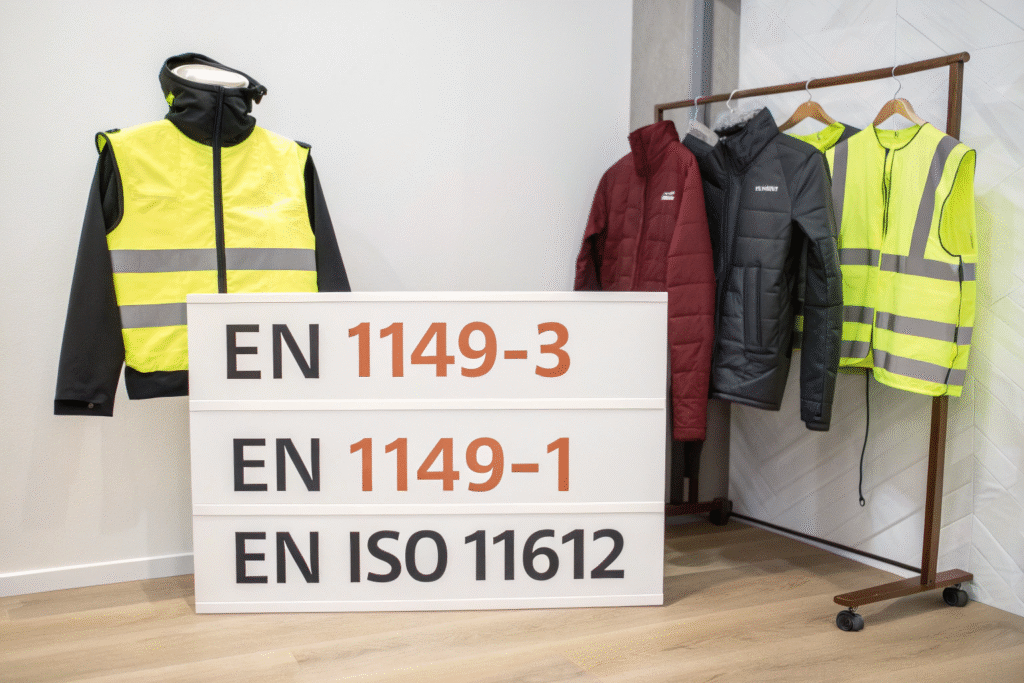Static electricity may seem harmless, but in industries dealing with electronics, chemicals, or flammable substances, it can cause serious accidents or costly damage. Electrostatic discharge (ESD) can ignite vapors, destroy sensitive components, and compromise workplace safety. For buyers sourcing protective garments, ensuring compliance with the right safety standards is about safeguarding both workers and business operations.
The EN 1149-3 standard ensures ESD garments can dissipate static charges quickly and effectively, reducing the risks of sparks and failures.
This standard deserves attention from buyers who want more than just comfort or price—they need assurance of safety, reliability, and long-term value.
What Does EN 1149-3 Really Test?
EN 1149-3 measures how fabrics handle static charges by testing charge decay time and shielding factor. Together, these indicators show how well a garment neutralizes static build-up in real-world conditions.

Why does charge decay time matter?
Charge decay time shows how fast static charges disappear from a fabric. A shorter decay time means fewer sparks. For example, HSE UK warns that static sparks in explosive atmospheres can easily trigger fires.
What is shielding factor in fabrics?
Shielding factor reflects how effectively a garment blocks charges from transferring to sensitive objects or electronics. This is critical in semiconductor manufacturing, where even minor discharges can destroy expensive components.
Which Industries Require EN 1149-3 Certified Garments?
EN 1149-3 garments are necessary wherever static risks are high.

Is it required in the electronics sector?
Yes. Electronics assembly, repair, and cleanroom operations rely on strict compliance. Organizations like IPC International recommend EN 1149-3 to reduce component failure and warranty claims.
Why is it crucial in oil, gas, and chemical industries?
In volatile environments, one spark can ignite vapors. That is why OSHA and similar regulators emphasize antistatic clothing in petrochemical sectors.
How Does EN 1149-3 Compare to Other Standards?
Different standards measure different risks, and EN 1149-3 plays a complementary role.

What is the difference between EN 1149-1 and EN 1149-3?
EN 1149-1 measures surface resistivity, but this alone cannot guarantee safety. EN 1149-3 adds real-world dissipation speed. According to European Safety Federation, both standards together provide complete coverage.
How does EN 1149-3 relate to EN ISO 11612?
EN ISO 11612 tests flame resistance, while EN 1149-3 ensures antistatic protection. In industries like oil & gas, garments often need both certifications, as noted by CEN Standards.
How Should Buyers Verify EN 1149-3 Compliance?
Verification is essential when sourcing internationally.

Should you request lab test reports?
Yes. Always request CNAS-accredited or SGS reports to confirm garments meet EN 1149-3 performance requirements.
Can digital tracking systems improve trust?
Yes. At Fumao Fabric, QR code tracking gives instant access to results like charge decay, shrinkage, and colorfastness testing. This transparency builds confidence in every order.
Conclusion
EN 1149-3 is not just another technical detail—it is the benchmark that ensures ESD garments truly protect workers and industries from static electricity hazards. Companies that understand and demand EN 1149-3 compliance are better prepared to protect their people, processes, and profits.
If you are looking for a reliable partner to produce or source EN 1149-3 compliant fabrics and garments, we at Shanghai Fumao are here to help. You can contact our Business Director Elaine at elaine@fumaoclothing.com to discuss your custom orders and ensure your supply chain meets the highest international safety standards.










